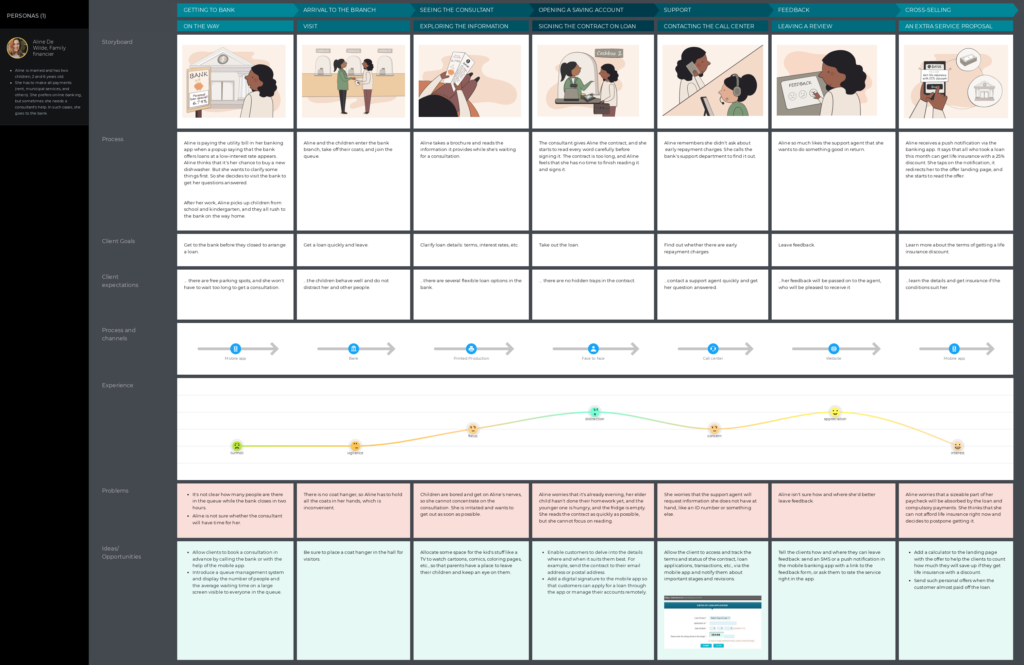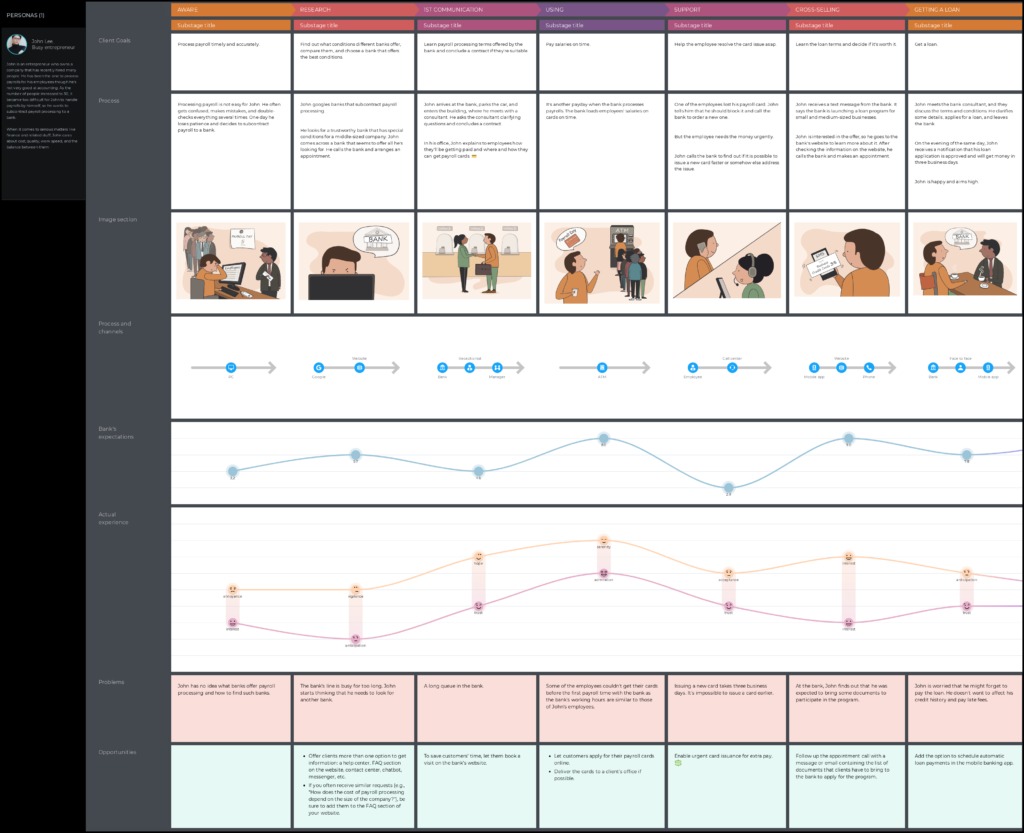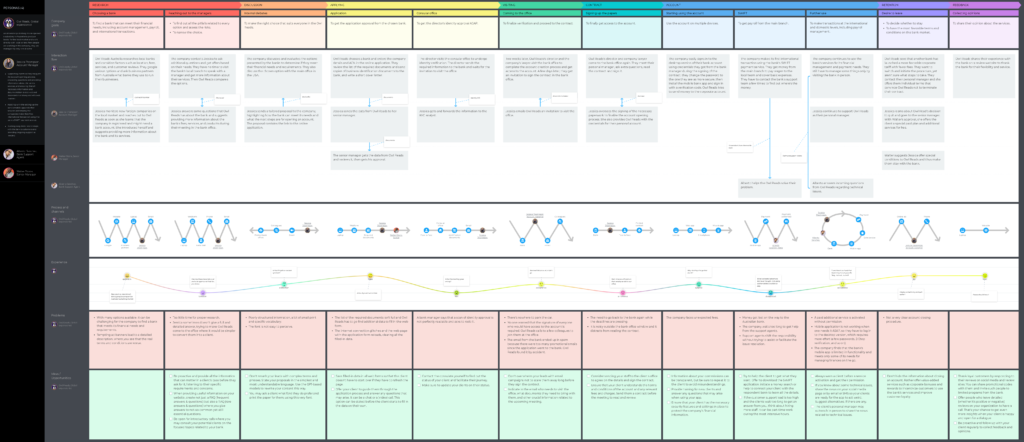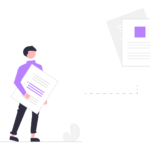A bank customer journey map can be a fruitful field for action plans and valuable insights that help to improve client experience in banking. However, it can also be a source of headache for those who have never practiced journey mapping as a tool to visualize bank customer journeys.
That's why we're here. Let's break down the beauty of creating a customer journey map in banking, understand how to approach this process, and what to do next.
Why bother about client experience in banking at all?
Finance has always been there and won't go away. We keep our savings in banks, borrow money, use financial products, interact with banks via apps and in person, and so on. It's just the way we live. Today, there are lots of banking organizations out there. That means the price of a mistake or a bad customer experience—a long queue in a branch near home, a buggy mobile banking app, contracts written for bankers or accountants, not ordinary people—is pretty high. After all, churn in banking is a real thing. People leave. With ease.
Contents
- 1 How to improve the client experience in banking?
- 2 What is a customer journey map in banking?
- 3 Why is customer journey mapping important for banks?
- 4 Research
- 5 B2C bank customer journey persona
- 6 How to create a customer journey map for banking services
- 7 A few tips for creating a bank customer journey map:
- 8 More examples of customer journey maps for banks
- 9 What’s next?
How to improve the client experience in banking?
There can be different approaches, but the best one is based on the real experience of an actual user. This way, you will be targeting your real audience, not just relying on fantasies. And this is where CJM comes into play.
First, you need to conduct proper research, identify your target audience, and then build a bank customer journey map to identify experience problems and ways to fix them, then put them into action. To help banks better understand their clients and start delivering the experience they are looking for, we created a B2C customer journey banking template to use as a starting point or a source of inspiration. You can see it below:
This template includes both a client persona and a map with a journey that the persona goes through.
And you can easily create a similar map, and we'll explain how right now.
But first…
What is a customer journey map in banking?
A customer journey map in banking is essentially a roadmap illustrating the steps your customers go through when interacting with your bank. These could involve opening a new account, using a mobile banking app, applying for a loan, or making a transaction. The map captures both the physical and digital interactions that customers experience, offering a visual narrative of their banking journey.
Customer journey mapping in banking helps financial institutions see things from their customers' perspectives. It details every touchpoint where customers interact with the bank, what they think, and how they feel about those interactions. This could include moments of frustration, like encountering a confusing process, or satisfaction, such as receiving helpful service during a bank visit.
Understanding the customer journey in the banking sector is crucial. With the rise of digital banking services and growing competition, banks need to ensure they're not just meeting but exceeding customer expectations. And there are more benefits of making a customer journey map in banking. Let’s list them below.
Why is customer journey mapping important for banks?
Customer journey mapping is a crucial tool for banks, providing valuable insights that can greatly enhance the customer experience and drive operational efficiencies. Here's why it's important for banks, along with examples from actual companies:
Improving customer experience in retail banking
- Enhanced in-branch service: Banks like Santander utilized customer journey mapping to optimize the in-branch experience, reducing wait times and improving the efficiency of service points.
- Optimized layouts: By understanding the flow of customer movement within branches, banks have redesigned interiors to facilitate easier navigation and more private discussions, enhancing the overall customer environment.
Enhancing online banking user journeys
- Streamlined online transactions: Wells Fargo implemented a customer journey map for online banking to streamline processes like account creation, bill payments, and loan applications, making the user interface more intuitive and reducing transaction times.
- User-friendly mobile apps: Mapping out the mobile banking journey has allowed institutions like Chase to enhance app functionality, focusing on features that users frequently access and simplifying tasks such as mobile deposits.
Targeting and personalization in marketing
- Customized marketing offers: Through customer journey mapping, banks can identify specific stages where customers might be receptive to particular products, allowing for more targeted marketing efforts. For example, Bank of America uses journey insights to tailor credit card offers to users who frequently engage with credit score features.
Identifying pain points and enhancing satisfaction
- Problem resolution: TD Bank uses customer journey maps to identify common pain points in the loan approval process. Insights gained have led to significant process adjustments, reducing approval times and increasing customer satisfaction.
- Improving customer retention: By addressing issues identified through journey mapping, banks can improve retention rates. Enhanced understanding of customer frustrations helps banks like Citibank implement corrective measures that keep customers satisfied and loyal.
Driving digital adoption
- Enhancing digital channels: By mapping the customer journey for digital platforms, banks have been able to promote the adoption of online and mobile banking services. For instance, HSBC used journey mapping to redesign its digital platforms for better usability, encouraging more customers to conduct transactions online.
Compliance and risk management
- Mitigating risks: Customer journey mapping helps banks ensure compliance with banking regulations at every customer touchpoint. By clearly understanding each step of the customer journey, banks can identify potential compliance risks and address them proactively.
Operational efficiency and cost reduction
- Streamlining processes: Journey mapping allows banks to streamline internal processes, which can lead to significant cost savings. For example, by identifying inefficiencies in customer service workflows, banks can redesign these processes to reduce operational costs and improve service speed.
Sounds great? Let’s proceed to the mapping part.
Research
It can be easy and challenging to gather the data needed to segment your target audience, create customer personas, and visualize their journeys. It's easy because you likely have a lot of customer data within your organization. But it's also a bit tricky because it will take some effort and perhaps getting to know your customers even better.
Ways to collect the info you need
- Ask your customers direct questions about their experiences, what's bothering them, and how satisfied they are with various aspects of your service. Use questionnaires and polls for this purpose.
- Talk to some of your customers individually. Your conversations can provide deeper insights into their experiences and emotions throughout their banking journey.
- Invite small groups of customers to gather and chat about their experiences and feelings regarding your bank. This can give you diverse perspectives and valuable insights.
- Visit the branches of your organization to watch how customers behave in person, or use tools like heatmaps and Google Analytics to observe their online interactions. This will help you see how they interact with your services in real time.
- Study records from your call center to learn what kinds of questions and complaints customers have. This data can highlight areas where your customer service needs improvement, which is the very information you can put into your journey map.
- Monitor customer discussions, complaints, and comments on social media platforms. Tools for social listening can help you track sentiment and trends.
- Look at how customers move money, pay bills, and use your various banking services by analyzing transaction data.
- Collect customer feedback through forms on your website, mobile app, or in your branches. Ask them about their experiences and what could be better.
B2C bank customer journey persona
With all of this data, you can divide your audience into groups based on specific parameters (e.g., motivations, frustrations, background, etc.) and bring them to life as personas.
So, what does a persona look like? Take a look at the profile of Aline, our sample persona, below.
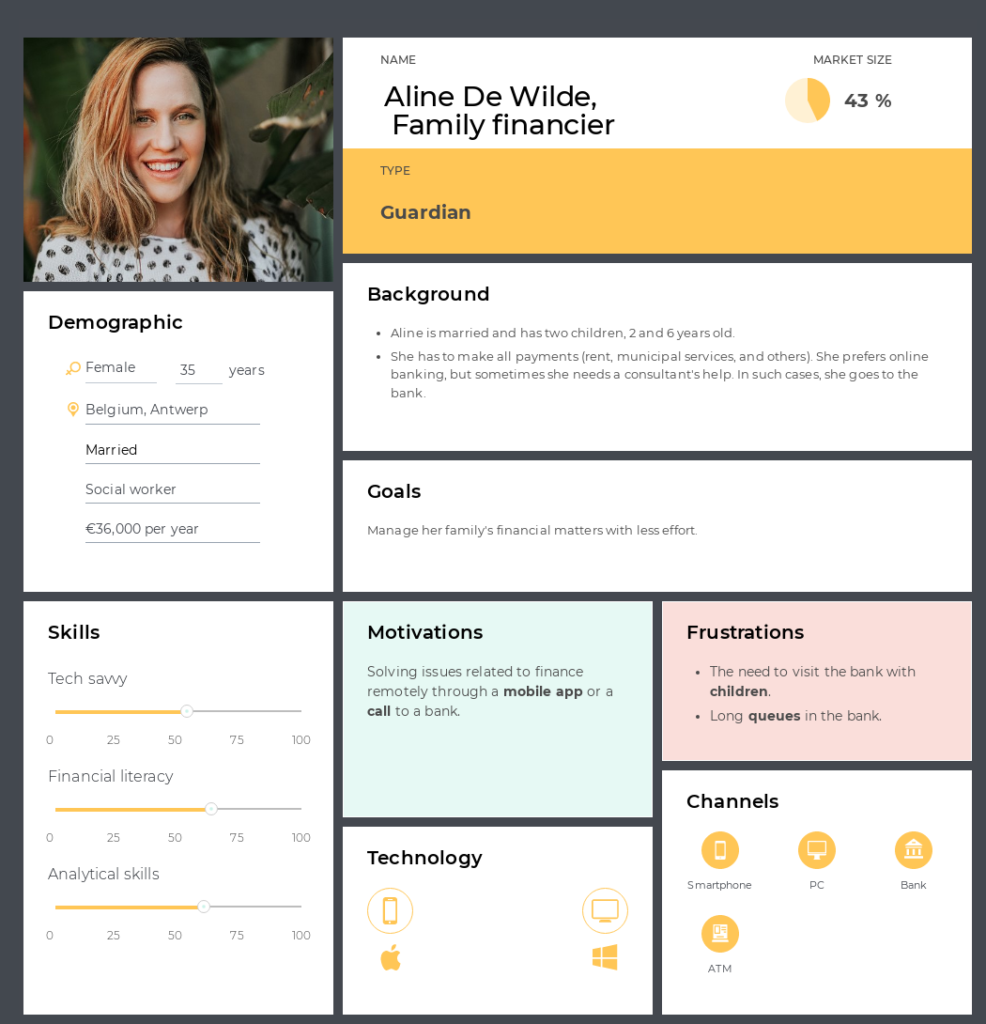
When building her profile, we paid more attention to how she behaves rather than her demographics. It was all about understanding why Aline does what she does.
For instance, motivations and frustrations help us figure out what makes our persona want to use our product or service and what could turn them off. The goal of a persona can be different, which also influences how we should interact with them. For example, one person might come to the bank to keep their money safe by making a deposit, while another might be here for a loan to grow their business. We also think about our persona's tech skills because they affect the communication methods we should use. For instance, it doesn't make sense to expect a persona to talk on the phone if they prefer chatting online.
Read also: Banking journey mapping case study
How to create a customer journey map for banking services
So, we've got our persona, Aline, and now it's time to craft her journey into a visual map. Let's dive into what we've designed for Aline's experience.
We are going to start with the stages in our sample customer journey map in banking. The journey begins with our persona rushing to the bank after work with her kids to apply for a vacation loan.
Stage 1. Getting to the bank
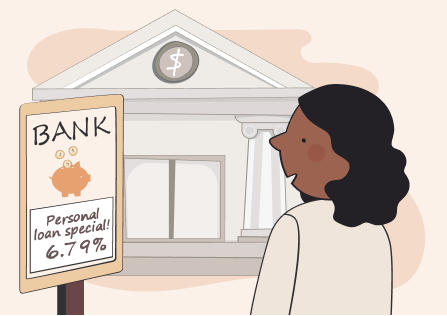
It would seem that the client has not yet entered, but their experience with your organization is already being formed.
Aline’s possible challenges:
- Aline wraps up her work during the evening rush hour and has to contend with heavy traffic. She also needs to pick up her children from daycare and make sure she doesn't arrive late for her bank appointment. This can be really frustrating and stressful, and it sets a bad tone for her visit.
- When she finally gets to the bank, she struggles to find a parking spot.
- The bank's entrance isn't very accommodating for wheelchairs or strollers. Aline, with her kids, has to navigate steep stairs or a narrow entrance, which is inconvenient and uncomfortable.
- To make things even worse, there are no clear signs outside or inside the bank to help Aline find the loan department. This confusion adds extra time and frustration to this step of her journey.
Potential solutions:
- The bank can invest in vibrant signage and directional indicators outside the office.
- Reserved parking spaces for bank customers with children or accessibility needs can enhance the overall experience.
- Renovating the entrance with a ramp or automated doors can make it more accessible for all customers, especially those with kids in strollers.
- Clear, user-friendly signages can swiftly guide clients to their destinations, reducing confusion and wait times.
Questions to ask yourself at this stage:
- Is our building easy to find?
- If a client arrives by car, will they be able to park at our building?
- Can the customer be sure they will be accepted if there is little time left before the bank closes?
Stage 2. Arrival
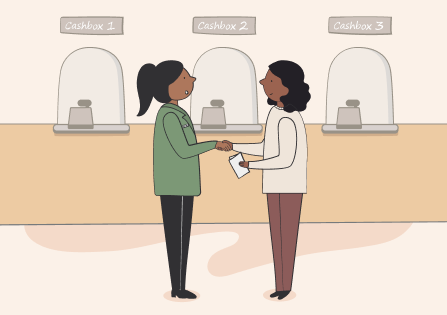
For a new client, the first visit to your branch forms a lot of stereotypes, and if they turn out to be negative, it will be difficult to change their mind afterward. But this stage also happens in the journey of regular customers, for whom comfort when visiting your organization matters no less.
Aline’s possible challenges:
- As Aline steps inside the bank, she's immediately confronted with a packed lobby teeming with customers. This can be overwhelming, especially when she has her kids in tow, and it might make her feel like she's lost in a crowd.
- Aline soon notices extensive lines at the customer service and loan application counters. This can be disheartening, as she may anticipate a long wait ahead.
- To make things more challenging, there isn't any bank staff to welcome or assist Aline as she enters. She's left to navigate the bank's layout all on her own, and this can be intimidating.
- Aline, accompanied by her children, struggles to find a comfortable place to wait. The bank seems to be lacking sufficient seating, which makes her experience less pleasant.
Potential solutions:
- Implement a robust queue management system that notifies customers of their expected wait times.
- Station bank personnel at the entrance to welcome customers, offer assistance, and guide them to the appropriate counters. A warm greeting can set a positive tone.
- Create a dedicated area for parents with children, equipped with toys, books, or games to keep kids engaged while waiting.
- Provide ample seating in the lobby area, ensuring comfortable spots for families. This improves comfort and convenience.
Questions to ask yourself at this stage:
- Is there a wardrobe for people to take off their outer clothing in the cold season?
- Is it comfortable to be in the building?
- Is there water available?
- Is the queuing system easy to use?
- Can clients sit comfortably or do they have to stand while waiting in line?
- Will our office be comfortable for customers with disabilities and/or children?
Step 3. Seeing the consultant
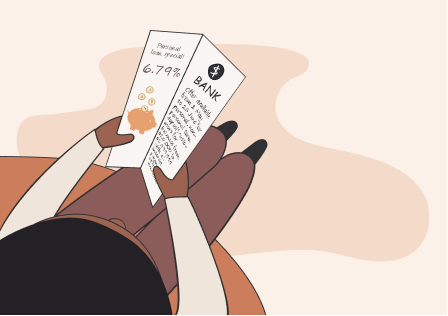
What can go wrong while communicating with a bank employee? For instance, a client may approach a newbie who lacks the required competencies to solve non-typical problems. It can be noisy in a bank and difficult to concentrate on what the bank employee is saying.
Aline’s possible challenges:
- Aline might have to wait longer to see a consultant because there may not be enough staff or due to long appointment queues. This can be frustrating, especially when she has her kids with her.
- If Aline and the consultant don't speak the same language or if the consultant uses technical jargon, they might not understand each other.
- Aline might not feel ready because she doesn't have enough information about the needed documents or how the application process works. This could lead to a frustrating experience.
Potential solutions:
- Implement an appointment scheduling system, allowing Aline to book a consultation in advance and avoid unnecessary waiting.
- Designate private spaces for discussions, ensuring Aline's comfort and confidentiality during her meeting with the consultant.
- Employ multilingual staff or provide translation services to bridge language barriers and ensure effective communication.
- Provide сlear information, either through your website, email, or via phone, to help clients like Aline prepare for their appointments, including required documents and the application process.
But there are other questions that need to be answered:
- What if the client came with children? Is there a children's corner, a TV with cartoons, or another way to distract the children so they do not interfere?
- Does the bank employee use clear and understandable language?
- Does the employee pitch additional services at inopportune moments?
Step 4. Opening a saving account
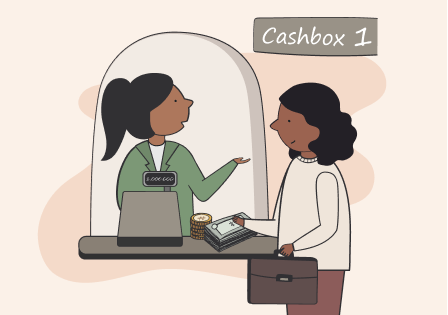
Contracts are a serious thing. Someone treats them lightly and signs without checking out, but it’s in the interests of the bank, so the client knows exactly what they are signing.
Aline’s possible challenges:
- Aline could feel overwhelmed by a stack of complex documents and forms needed for opening an account.
- If there are delays in processing her application, it might lead to a prolonged waiting period, causing frustration or uncertainty.
- When Aline isn't provided with a range of account options tailored to her specific needs, she might get the impression that the bank isn't offering the best solution for her.
- Additionally, Aline might lack knowledge about savings accounts, interest rates, or associated fees, and this gap in information can make it challenging for her to make informed decisions.
Potential solutions:
- Offer clear instructions to help Aline complete the required documents and forms.
- Keep Aline informed about her application status, interacting with her via phone, online chat, email, or push notifications. Regular updates and estimated processing times can reduce uncertainty.
- Provide a range of savings account options and assist Aline in choosing the one that best suits her financial goals and circumstances.
- Offer educational resources or consultations to help Aline understand savings account features, interest rates, and fees. This will empower her to make informed decisions.
Check yourself with the following questions:
- Is the information in the contract clear and understandable?
- Is an easy-to-read font used in the contract?
- Can the employee briefly describe in simple terms each clause of the contract?
- Is it possible to delay the signing so the client can read the contract at their own pace?
Step 5. Support
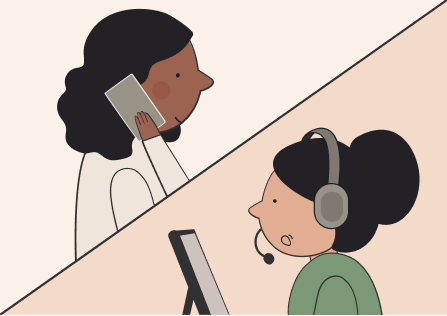
Clients often have questions: they may be far from financial subtleties, deal with bugs in a mobile banking app, the website usability may have some issues, etc.
Aline’s possible challenges:
- If Aline faces challenges accessing customer support, it can be a frustrating experience, especially when she has questions or concerns that require immediate attention.
- Extended wait times for responses to her inquiries or issues may lead to impatience and frustration, making Aline feel that her concerns are not a priority.
- If Aline's problem is complex, she might have a hard time figuring it out and solving it on her own.
- Additionally, suppose Aline can only contact the bank through one way, like only using the phone. In that case, it might not match her preferred way of communicating.
Potential solutions:
- Provide various customer support channels, including phone, email, chat, and in-person assistance, to accommodate Aline's preferred method of communication.
- Establish clear response time standards for addressing customer inquiries or issues to ensure timely resolution.
- Offer accessible and straightforward guidance for customers like Aline, who may need help with more complex issues, perhaps through self-service resources or personalized assistance.
- Implement proactive communication to keep Aline informed about important account updates or changes, ensuring she feels well-informed and supported.
The questions below will help you find out the pain points at this stage:
- Through what channels can customers contact our support?
- Do we have a bot that can take care of typical issues and free up human labor for more complex issues?
- What are the support hours, considering our customers may be in various time zones?
- How do support staff behave if they don't know the answer to a customer's question?
- How quickly does the client receive a response?
Step 6. Feedback
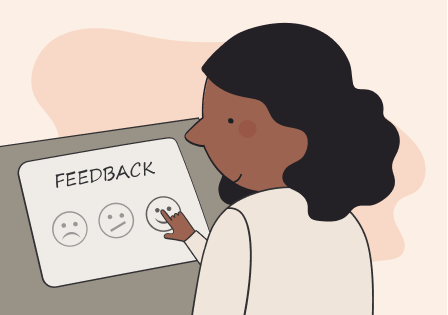
To find out about problems in customer experience, you need to communicate with the people you serve. Of course, you can check bank review sites and forums and search social media for clients' opinions, but you can simplify things and give the clients convenient ways to express themselves.
Aline’s possible challenges:
- Suppose Aline faces difficulties in providing feedback because of unclear channels or a feedback process that's not user-friendly. In that case, she may hesitate to share her insights.
- Aline might feel that her feedback isn't valued or that the bank isn't responsive to customer input.
- Concerns about the anonymity of her feedback could make Aline hesitant to offer candid comments or suggestions.
- Aline may feel that her feedback is ignored if she doesn't receive acknowledgment or a response to her comments, which can be disheartening.
Potential solutions:
- Create easily accessible feedback channels, such as online forms or surveys, within the bank's digital platforms and physical branches.
- Develop a responsive system for handling and acknowledging customer feedback. Ensure that Aline knows her input is valuable and appreciated.
- Offer anonymous feedback options to address privacy concerns. Allow Aline to share her thoughts without revealing personal information.
- Establish a feedback loop where Aline is kept in the loop regarding the outcomes of her feedback. Such an approach demonstrates the bank's commitment to making improvements based on customer input.
Ask yourself:
- Do our clients use social media? Are we present on their favorite social media platforms?
- Do we have feedback forms on the website and app so clients can fill out them after talking to support, submitting a loan application, or even checking their personal accounts?
- Do we respond to feedback, or does it gather dust?
- Do we contact customers after processing their feedback and taking action?
Step 7. Cross-selling
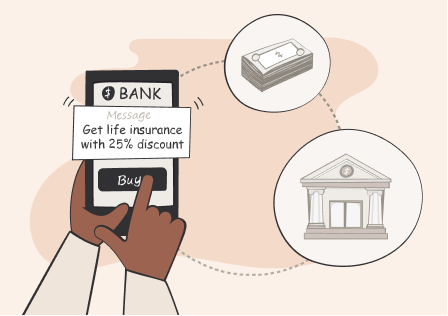
Additional services should be commensurate with the capabilities of your customers. For example, if a person in a difficult situation has taken out a loan, it makes no sense to promote favorable insurance plans or a new loan to them. It would be better to wait until the last payment is made and only then share new offerings. Or when your client buys a vehicle, it's only fair to suggest they get car insurance.
Learn more about such journeys in our article dedicated to car insurance journey map creation.
Alina’s possible challenges:
- If the bank's attempts to offer additional services don't match Aline's needs, she might think they are too pushy or sales-focused, which could make her unhappy.
- Aggressive sales tactics or excessive persuasion can make Aline uncomfortable and may discourage her from considering additional products or services.
- When the offers are not tailored to Aline's financial situation or her history with the bank, she might not see the value in the proposed products.
- Furthermore, Aline may be concerned about transparency and whether the bank's cross-selling practices align with her best interests, which can influence her decision-making.
Potential solutions:
- Tailor cross-selling efforts based on Aline's financial history and preferences, ensuring that the offers are relevant and valuable to her.
- Focus on providing relevant and timely information on the additional products or services rather than aggressive sales tactics.
- Clearly communicate the benefits and terms of the proposed products, giving Aline the freedom to choose based on her understanding and needs.
Some things to consider when mapping out this stage:
- Do we differentiate the promotional offers across our personas?
- Doesn't our customer's email box look like a graveyard of sales offers?
- How understandable are promotional offers for ordinary customers? Do we attach interest calculators to them?
That’s it. Our map template includes all these steps with the persona’s goals, expectations, thoughts, actions, and emotions. We hope it will give you a deeper understanding of the bank client's experience, and you will build a map based on your own case, identify customer experience gaps, and discover opportunities for improvement at all the journey stages.
A few tips for creating a bank customer journey map:
- Use real data to base your bank customer journey map upon. Otherwise, all the ideas you will come up with during brainstorming won’t do any good.
- Don’t do everything alone. You don’t need a team to launch a mapping project, but you certainly need one to collaborate on your map, finish it, and get buy-in from top management.
- Use images to illustrate your customers’ journeys, website screenshots, documents, and other content that add more dimensions to the map.
- To enhance empathy, use your customer’s quotes obtained during customer interviews, seen on the forums and review websites, received in surveys, and so on.
- Update your banking customer journeys regularly. Personas’ goals change over time, some problems are getting fixed while new ones appear.
More examples of customer journey maps for banks
B2C customer journey mapping represents just one aspect of the banking experience. On the other side, there's B2B, which is equally crucial. We offer several templates designed specifically to assist with mapping the B2B customer journey, helping you to better understand and serve your business clients.
The first is one of templates for business journey mapping banking:
The second is focused on the corporate banking client journey:
Feel free to use any of them and tweak them to your case.
What’s next?
What's next after creating the map? It's the perfect moment to gather valuable insights about your customer experience and craft a plan to enhance it.
To do this, gather your team of engaged colleagues for a workshop, secure the support of key stakeholders from top management, and you're all set to go.
GO TO UXPRESSIA
P.S. Need a banking journey template for business? Find it here.
